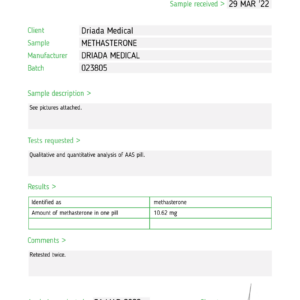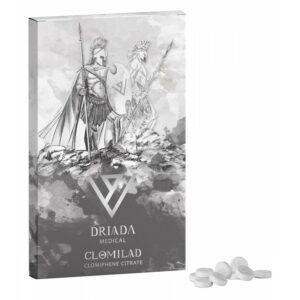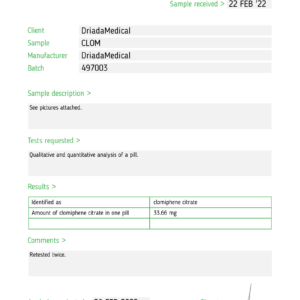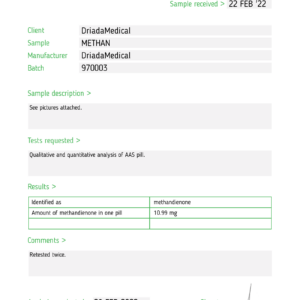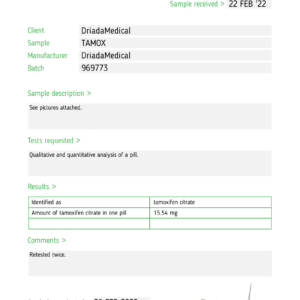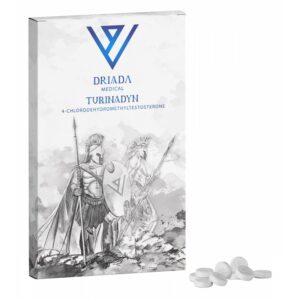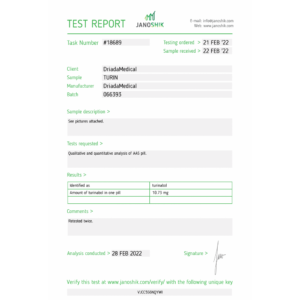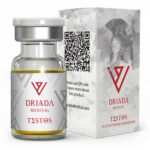What is modafinil
Modafinil is one of the most popular drugs in the nootropic group, which is taken to enhance cognitive functions and improve brain performance. It has gained significant popularity among people whose work involves mental tasks or requires increased concentration. Specifically, this drug is highly favored by students, IT specialists, and long-haul truck drivers.
Modafinil is a selective alpha-1 adrenergic agonist primarily of central action. It acts as a psychostimulant, boosting cognitive performance. Originally developed for the treatment of narcolepsy, Modafinil became the first drug in its class to promote wakefulness and was approved in the United States in 1998. During trials, patients taking Modafinil stayed awake for 28 hours, maintaining their attention and alertness. Media reports suggest that the drug is actively used by the US and UK military to enhance performance, especially among pilots. Modafinil reduces the need for sleep and can be effectively used to increase attention and concentration.
According to the commonly accepted classification, Modafinil is both a nootropic and a eugeroic. Eugeroics are substances that have a stimulating effect, reducing sleepiness and promoting wakefulness. A typical example of a eugeroic is caffeine. Modafinil belongs to the same group, activating neurotransmitters responsible for wakefulness. Additionally, Modafinil enhances cognitive functions, exhibiting nootropic properties, which makes it useful for improving memory and focus. Considering its long half-life, it can offer operational advantages by enhancing tolerance to the detrimental effects of prolonged mental exertion.
Purpose to use
The use of Modafinil serves various purposes, both within medical settings and beyond. Below are the most popular reasons for using Modafinil:
Medical Use
In medicine, Modafinil is employed to treat sleepiness associated with narcolepsy. It is approved for the treatment of sleep disorders related to shift work and excessive daytime sleepiness. Additionally, in some countries, Modafinil is approved by regulatory authorities for treating cases of idiopathic hypersomnia (pathological daytime sleepiness with an undiagnosed cause).
Off-label Use in Medicine
Modafinil is also popularly used off-label as a relatively safe psychostimulant. For instance, it is used to treat lethargy and fatigue associated with depression, fibromyalgia, chronic fatigue syndrome, myotonic dystrophy, and sleepiness caused by opioids. It improves subjective mood and can be used to address circadian rhythm disorders resulting from jet lag.
Modafinil can also be an effective and well-tolerated treatment for patients with seasonal affective disorder. Some doctors may also prescribe it for individuals with “night owl” syndrome. There is evidence suggesting that Modafinil, when used on its own, is effective for certain subgroups of people with depersonalization-derealization syndrome. The subgroups that tend to respond most frequently to Modafinil include individuals with attention deficits, low nervous system excitability, and increased sleepiness.
Non-Medical Use to Enhance Performance
By influencing brain cells, Modafinil enhances cognitive functions, leading to increased work capacity, activity, vigilance, focus, and concentration. Consequently, many perceive it as a brain-enhancing “smart drug.” Professionals engaged in mental work, such as programmers, gamers, and students, use Modafinil to boost productivity. It is widely used off-label to suppress the need for sleep, while also enhancing short-term memory after sleep deprivation.
Military Use: Several countries’ military forces have shown interest in Modafinil as an alternative to amphetamines – drugs traditionally used in combat situations where troops face sleep deprivation, such as during extended missions. In the US military, Modafinil has been approved for use in various Air Force operations and is being studied for other purposes. Studies have suggested that Modafinil, when administered in divided doses of 100 mg, can maintain flight control accuracy among sleep-deprived F-117 pilots at around 27% of baseline levels for up to 37 hours without significant side effects.
Space Missions: Astronauts on long missions aboard the International Space Station have used Modafinil to optimize performance during periods of fatigue. It helps with circadian rhythm disruptions and poor sleep quality experienced by astronauts. Similarly, during high-risk, large-scale, and prolonged law enforcement operations in Maryland, USA, field doctors can issue 200 mg of Modafinil once a day to law enforcement personnel to improve attention, concentration, and functioning under conditions of limited rest.
Cocaine addiction
Modafinil is being investigated as a possible treatment for cocaine addiction due to several reasons related to the biochemical mechanism involving both drugs and observations that the clinical effect of modafinil is partially opposite to the symptoms of cocaine withdrawal. In a double-blind study of modafinil in individuals seeking treatment for cocaine addiction, significant improvements were noted in some parameters, such as the maximum number of consecutive days without cocaine use, but no statistically significant effect on the rate of change in percentage of cocaine-free days was found.
Weight Loss
Studies of modafinil, even in individuals with a healthy weight, indicate that it influences appetite suppression and weight loss. All modafinil studies in the Medline database, lasting for one month or longer and reporting changes in weight, show that modafinil users experience weight loss compared to placebo. In 2008, a small study on individuals with simulated shift work demonstrated a reduction in calorie intake by 18% with 200 mg of modafinil per day and a decrease of 38% with 400 mg per day.
Mechanism of Action
Despite intensive research on the interaction of modafinil with various neurotransmitters, the exact mechanism or complex of mechanisms remains unclear. Scientists are still studying how modafinil affects the human body. It is known that the drug influences various neurotransmitters in the brain that are responsible for alertness, concentration, and focus. It is believed to affect several different pathways in the brain, creating a stimulating effect and enhancing cognitive functions. Modafinil likely increases the release of monoamines, especially norepinephrine and dopamine, from synaptic gaps, similar to other stimulants.
Modafinil impacts the brain by activating various biochemical processes. It stimulates the production of dopamine and related neurotransmitters, indirectly increasing brain activity and improving cognitive functions (executive functions). These changes allow individuals to more effectively tackle mental tasks, make quick decisions, and maintain concentration for longer periods. Due to its ability to increase dopamine levels in the brain, Modafinil is prescribed to individuals with attention deficit hyperactivity disorder (ADHD) who have critically low dopamine levels, leading to concentration problems and attention deficits.
During clinical studies, it was found that Modafinil possesses neuroprotective and antioxidant properties. It helps increase cortical creatine levels while reducing oxidative processes in the brain, which also contributes to improved concentration. Additionally, it suppresses the activity of compounds responsible for fatigue and, conversely, activates substances that promote wakefulness.
Furthermore, Modafinil increases the level of histamine in the hypothalamus, leading some researchers to consider it more of a “wakefulness-promoting agent” rather than a classical amphetamine-like stimulant.
Research indicates that Modafinil has a “low potential for serious abuse” and “does not produce addiction in first-time users.” The combined action of Modafinil on both catecholamine and histamine pathways reduces its abuse potential compared to traditional stimulant drugs, while still maintaining its effectiveness as a wakefulness-promoting medication.
Numerous studies demonstrate an increase in the levels of monoamines, specifically dopamine in the striatum and nucleus accumbens, norepinephrine in the hypothalamus and ventrolateral preoptic nucleus, and serotonin in the amygdala and frontal cortex. Modafinil activates the glutamatergic pathway, inhibiting GABAergic nerve signal transmission.
Effects
- Improves memory
- Enhances attention and cognitive function
- Reduces the need for sleep
- Improves mood and motivation
- Decreases appetite and calorie consumption by 18%
- Reduces daytime sleepiness
Side effects
There is a risk of developing neurological, skin, and allergic side effects, although these side effects are most commonly observed during the first two weeks of using the medication. • Back pain, headache
- Nausea
- Feelings of anxiety
- Nasal congestion
- Diarrhea
- Dizziness
- Dyspepsia
- Insomnia
- Severe allergic reactions
- Hives
- Formation of ulcers in the mouth
- Formation of blisters or peeling skin
- Swelling of the face, eyes, lips, tongue, legs, or throat
- Swallowing and breathing difficulties
- Fever
- Shortness of breath
- Yellowing of the skin and eyes
- Darkened urine
- Increased blood pressure
Half-life
The bioavailability of modafinil is over 80%. The average maximum concentration is reached approximately 2-3 hours after administration. Co-administration with food slows down absorption but does not affect the overall area under the pharmacokinetic curve (“concentration-time”). The half-life usually ranges from 10 to 15 hours and can vary based on the genotype of cytochrome P450 enzymes and liver and kidney function.
Contraindications
- Hypersensitivity to the drug
- History of cardiovascular diseases, especially during the use of other stimulants or in cases of liver cirrhosis
- Heart conditions, particularly left ventricular hypertrophy or mitral valve prolapse
How to use
People with sleep deprivation are prescribed this medication to maintain wakefulness throughout the day. Healthy individuals take it to enhance motivation and cognitive abilities. For individuals with hyperactivity, this medication helps to focus on complex tasks more easily. Additionally, modafinil allows a person to stay alert and focused for longer durations, making it easier to perform challenging tasks. This effect persists as long as there is a sufficient concentration of modafinil in the body.
Dosages
For the treatment of hypersomnia associated with narcolepsy and obstructive sleep apnea, a single dose of 200 mg in the morning is recommended, although there is clinical trial data suggesting that the twice-daily administration (in the morning and at noon) of 200 mg is more effective. A single dose of 400 mg does not significantly increase efficacy compared to the 200 mg dosage.
For the treatment of sleepiness associated with shift work, a single dose of 200 mg of the medication is recommended 1 hour before the start of the shift. Good effects can also be achieved with a single dose of 300 mg. Individuals particularly sensitive to the medication may experience a significant effect with a dosage of 100 mg.
In all cases, the daily dosage should not exceed 400 mg. Taking the medication in the second half of the day is not recommended as modafinil is slowly excreted from the body (half-life 12-15 hours) and may interfere with normal nighttime sleep. In general, dosage recommendations range from 100 to 400 mg per day, divided into 1-2 doses.
The recommended initial dosage of the drug is 50-100 mg, gradually increasing it to 200 mg or more until the desired effect becomes noticeable.
Safe Dosages
While some individuals may take as little as 50 mg of the substance per day and find it sufficient to experience the desired effects, others may require higher dosages to achieve a similar effect. Therefore, it is impossible to definitively determine which dosage is more appropriate since it depends on individual body characteristics.
The standard initial dosage of the medication is 50 mg per day. Then the dose can be gradually increased until the desired effect is achieved. In most cases, modafinil is taken at a dosage of 200 mg per day. The maximum allowable dosage is 400 mg per day.
If you plan to take modafinil daily for an extended period, it is better to stick to the lower end of the dosage range. This minimizes the risk of undesirable side effects. Dosages close to the maximum allowable limit are more suitable for one-time administrations when it is essential to achieve a strong effect immediately. Additionally, higher dosages of modafinil may be required for individuals with accelerated metabolism.
Overdose
Symptoms of overdose are possible only if a person exceeds the maximum daily dose of the medication, i.e., takes more than 400 mg of modafinil. In the case of taking an excessively high dose of modafinil, symptoms similar to side effects may occur. These may include anxiety, restlessness, confusion, sleep disturbances, diarrhea, tachycardia, hallucinations, nausea, tremors, chest pain, and other symptoms.
Lack of Effects
Different individuals may experience the effects of modafinil differently. Very rarely, but it happens that the medication does not cause any effect at all. For example, some individuals, especially those who have just started using the drug or those who have been taking it for a long time and in high doses, may not experience the desired effects.
Can Modafinil be taken daily?
Daily use of the medication is indicated for the treatment of narcolepsy, sleep apnea, ADHD, multiple sclerosis, and some other chronic conditions. The frequency and duration of modafinil intake depend directly on the intended goal. People prescribed this medication by a doctor must strictly follow the dosages indicated by the doctor.
However, the optimal dosing regimen for enhancing productivity is 2-4 times a week. For some individuals, taking modafinil 1-2 times a month may be sufficient as a “rescue aid” when they need to tackle urgent tasks.
If taking modafinil daily to enhance productivity and improve concentration, it is essential to observe certain rules. In particular, it should be understood that with daily use, the medication is never completely excreted from the body. Therefore, during this time, it will be necessary to abstain from alcohol and cigarettes. It is also important to be aware that after discontinuing the use of the drug, withdrawal syndrome is likely to occur.
The frequency and duration of modafinil intake depend directly on the intended goal. People prescribed this medication by a doctor must strictly follow the dosages indicated by the doctor. Individuals who have independently decided to take modafinil to boost activity should consider the peculiarities of their own body and pay attention to its reactions to the medication. Some people take tablets daily to get the necessary energy boost, while others may only use the medication in special situations, such as before an exam or during the preparation of particularly challenging projects.
The best advice in this case is to take the medication only when it is genuinely essential to enhance cognitive functions or maintain concentration for an extended period.
Influence on Sleep
If modafinil is taken in small doses, it will not affect the night’s rest. After the wakefulness phase, as usual, a sleep duration of 7-8 hours will occur. However, it should be noted that the half-life of this medication is 12-15 hours, and this figure may vary depending on the individual’s metabolism rate. This means that by the end of the day, a certain amount of modafinil may still remain in the blood. Therefore, to avoid disrupting your regular daily routine and prevent insomnia, modafinil in doses up to 400 mg should only be taken in the morning. Failure to follow these recommendations may result in a deterioration of the quality of nighttime sleep while taking the medication.
How Long Can One Stay Awake on Modafinil
If the dosage is correctly calculated, wakefulness can be maintained for 22 hours or more while taking modafinil. In some cases, the effect of this potent eugeroic can last up to 40 hours. This makes it highly popular among people whose work demands prolonged activity and concentration. For example, it can be beneficial for long-haul truck drivers who need to remain alert for many hours.
Modafinil and Withdrawal Syndrome
If modafinil is taken for an extended period and in high doses, symptoms of withdrawal syndrome may occur after discontinuation. The longer a person has been taking the tablets, the more intense these symptoms may be. To make the process of discontinuing modafinil less painful, it is advisable to gradually reduce the dosage of the medication. After abrupt discontinuation, problems with concentration, fatigue, depression, sleepiness, shortness of breath, and weakness may occur. These symptoms, especially severe weakness, are most noticeable in the first week after stopping the medication. However, people taking modafinil in small doses usually do not experience any withdrawal symptoms when discontinuing it.
Addiction
Despite having some biochemical similarities with addictive stimulants, modafinil has significantly lower addictive properties. In other words, the risk of developing dependence on modafinil is minimal, which sets it apart from other stimulants like amphetamines.
Combination with Other Drugs
Below are some potential combinations of modafinil with other medications. It is important to understand that modafinil is a CNS stimulant, so even if there is no information about combining modafinil with other stimulants, their effects can be potentiated, leading to various side effects.
Contraceptives
Modafinil may reduce the effectiveness of some contraceptive medications, which can result in unplanned pregnancies.
Yohimbine
Combining modafinil with yohimbine can cause a dangerous increase in heart rate and blood pressure.
Caffeine
If you decide to take caffeine and modafinil simultaneously, it’s important to know that both substances have a strong impact on the nervous and cardiovascular systems. Therefore, if you have any minor cardiovascular or nervous system issues, daily consumption of modafinil and caffeine may be unsafe.
Dopamine Receptor Antagonists
While co-administration of amphetamines with dopamine receptor antagonists reduces the stimulating effect of amphetamines, co-administration of dopamine receptor antagonists and modafinil does not fully diminish the wakefulness effect of modafinil.
Modafinil and Alcohol
Simultaneous use of modafinil and alcohol can be dangerous. This is because these substances, from a biochemical perspective, induce opposite reactions in the brain. Alcohol increases the activity of gamma-aminobutyric acid (GABA) and reduces glutamate activity. In contrast, modafinil acts as a source of GABA and accelerates glutamate synthesis. Additionally, alcohol inhibits many processes in the brain, while modafinil stimulates brain activity. The result of this “tug of war” in the brain can be unpredictable.
MAO Inhibitors
Data on the drug interaction between modafinil and MAO inhibitors are not available. Therefore, if MAO inhibitors and modafinil are used together, caution should be exercised.






